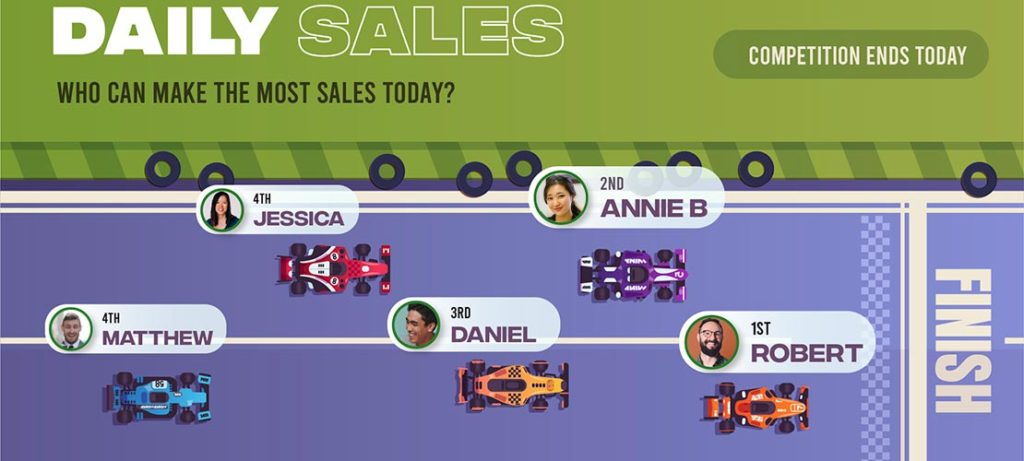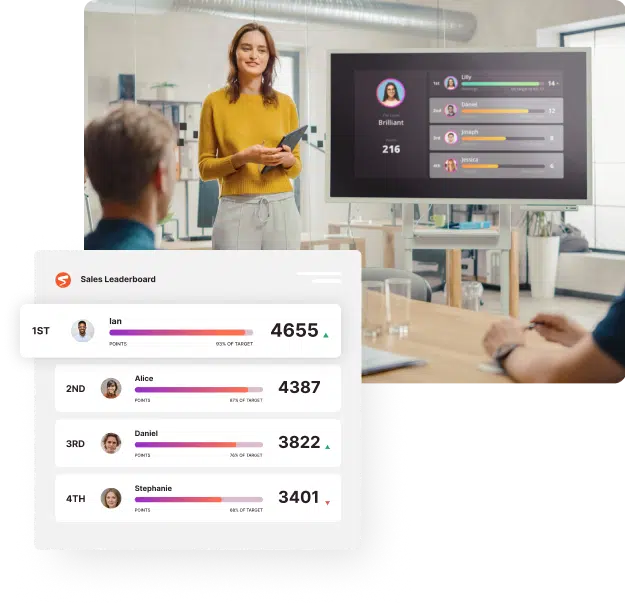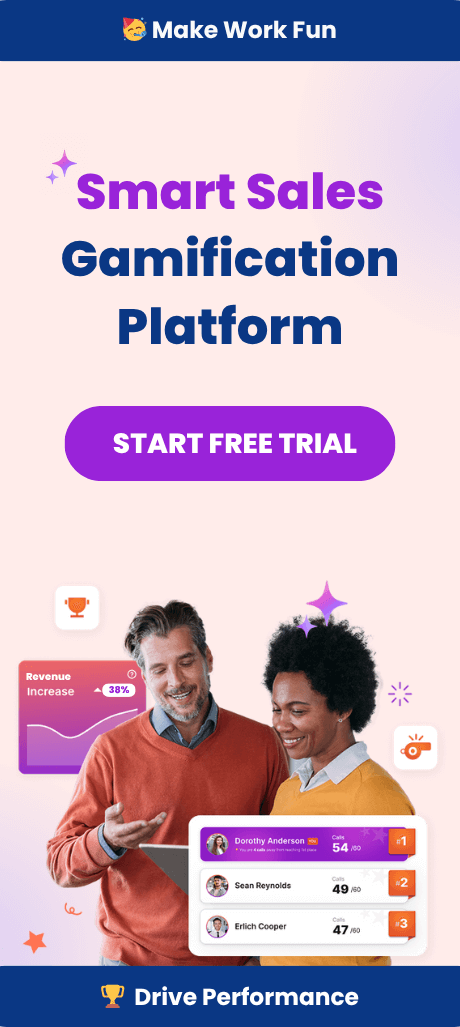Sales gets a bad rap. It’s often seen as high pressure, repetitive, and driven solely by quotas. But what if it didn’t have to be that way? What if you could transform your sales culture from burnt out and bored to energized, engaged, and even… enthusiastic?
Sounds ambitious—but it’s 100% possible. With the right strategies—especially those borrowed from game design elements—you can build a productive sales team that doesn’t just perform… they actually love their job. Many gamification strategies used in sales today are inspired by the evolution of video games, which have shaped how we engage and motivate people in non game contexts. To be effective, it’s crucial to understand your target audience so that game elements are tailored to your team’s motivations and needs.
In this blog, we’re revealing 10 smart, scalable, and surprisingly fun ways to turn your sales org into a winning sales culture. You’ll learn how companies like Zendesk, Atlassian, Salesforce, and Spinify are using modern psychology, gamification elements, and culture-first leadership to drive not just numbers—but joy.
Let’s play.
The Sales Burnout Problem: Why Work Feels Like a Grind
Before we fix it, we need to face it. The average sales rep is:
- Constantly chasing shifting targets
- Overwhelmed by data, dashboards, and pressure
- Lacking regular feedback or recognition
- Stuck in a rigid sales process
Low employee engagement, ineffective performance management, and limited knowledge retention all contribute to the sales burnout problem.
No wonder 67% of B2B sales reps report feeling disengaged.
We don’t fix this with perks. We fix it with purpose. And that means designing an environment where reps want to show up.
Game-Changer: Sales Meets Gamification

Gamification strategy is about applying game mechanics—the same ones used in computer games—to non-game environments like work.
The term gamification refers to the process of implementing gamification by integrating game design elements such as rewards, leaderboards, and progress tracking into non-game contexts like sales. Implementing gamification in sales involves using these elements to create engaging experiences and motivate teams. This is how gamification works: by leveraging game principles to enhance engagement and drive desired behaviors.
Why? Because games are designed for user engagement. They reward effort, show progress, and offer meaningful feedback.
Sales teams thrive on the same ingredients. That’s why adding gamification elements to your sales process can transform effort into enjoyment.
Creating a Gamification Strategy(NEW: Bridge between inspiration and action—how to plan your approach)
Tip 1: Replace Boring KPIs with Game Missions
Instead of saying, “Make 80 calls,” say, “Complete today’s prospecting quest.” Game language reframes tasks as challenges.
Companies like Microsoft use this technique to drive internal engagement in training and customer outreach campaigns by incorporating elements of game design, such as missions, points, and rewards, to make sales tasks more engaging. When reps feel like they’re on a mission—not a chore—they show up with more energy.
Tip 2: Use Real-Time Leaderboards (But Make Them Fun)

Leaderboards aren’t just for competition—they’re for visibility. But here’s the trick: make them inclusive.
Spinify allows companies to create dynamic, customizable leaderboards that spotlight not just top closers, but most improved, fastest follow-up, or most consistent CRM updates. This fosters a supportive sales culture, not just a cutthroat one. Leaderboards also encourage friendly competition and healthy competition among sales teams, while promoting social interaction through features like real-time progress tracking and shared celebrations.
Tip 3: Reward Progress, Not Just Outcomes
Games reward you for leveling up—not just winning. Your sales strategy should do the same.
Create badges or bonuses for:
- Hitting activity milestones
- Improving conversion rates
- Completing training quests
Incorporating external rewards, such as badges and bonuses, along with point systems, provides positive reinforcement that motivates sales reps to achieve milestones. These gamification elements encourage engagement, recognize achievements, and promote a positive work environment.
Zendesk gamified rep training using tiered achievements. Result: faster ramp time and more reps reaching quota.
Tip 4: Build Streaks and Series for Momentum
Ever used Duolingo? One missed day and you feel it. That’s the power of streak psychology.
Apply this to sales: reward reps for consecutive days of logging activity or booking meetings. The longer the streak, the better the reward. Progress tracking and visual representations, like streak meters or achievement badges, help reinforce momentum by showing reps their advancement and providing immediate feedback.
Spinify makes it visual and celebratory—exactly how the brain likes it.
Tip 5: Make Recognition Public and Celebratory

Games shout when you win. So should your sales team.
Use gamification platforms to automate celebrations in Slack, on TVs, or in Zoom calls. When a rep closes a deal, everyone hears about it. Some gamification platforms also reward achievements with virtual currency, which can be redeemed for perks and further motivates team members.
Atlassian uses public recognition programs internally to build culture—and loyalty.
Tip 6: Use Mini-Games for Micro-Motivation
Gamification isn’t just big dashboards. Try weekly mini-games like:
- “Beat the Boss” challenges
- “Quickest Dialer” races
- “Demo Streak Showdown”
Using different game mechanics—such as points, badges, leaderboards, and narrative—in these mini-games keeps motivation high and prevents monotony by making each challenge feel fresh and engaging.
Short, fun sprints that build team energy. Combine them with small rewards—think lunch, badges, or even extra coffee credits.
Tip 7: Personalize Challenges by Skill Level
Not every rep should play the same game. New reps need onboarding XP. Veterans need strategic mastery quests.
Segment your challenges and rewards based on skill level to keep everyone challenged and engaged. Personalized challenges not only boost motivation but also support skill development and gamified learning, helping sales reps grow their abilities through targeted quests and interactive experiences.
Spinify enables tailored missions per user—no one’s left behind.
Tip 8: Add Visual Progress Indicators

Games always show you how far you’ve come. Your sales process should too.
Use progress bars, completion meters, and achievement tracking. Salesforce uses gamified progress widgets to help users stick to new tools. Visual progress indicators also support performance management by making employee growth and achievements visible, which encourages goal-oriented behaviors and improves workplace productivity.
When reps can see their growth, they believe in their future.
Tip 9: Tap Into Team-Based Competition
Competition doesn’t have to be solo. Teams can compete too—and that builds unity.
Run weekly team challenges: North vs. South, SDRs vs. AEs, even randomized squads. Use leaderboards to track group effort. Team-based competition not only fosters team collaboration by encouraging shared goals and teamwork, but also recognizes the contributions of each team member and all team members, boosting motivation and performance.
Spotify famously encourages internal competitions between dev teams—it works in sales, too.
Tip 10: Let Reps Design Their Own Games
Gamification thrives on autonomy. Ask your team:
- What motivates them?
- What goals feel fun to chase?
- What’s a “win” that excites them?
Co-designing contests creates ownership—and customer loyalty, because happy teams deliver better experiences. Involving reps in the game design process also helps encourage participation, as they feel more invested and engaged in the activities.
Promoting Gamification: How to Get Buy-In, Drive Adoption, and Keep the Energy High
Successfully implementing a gamification strategy requires more than just launching game elements—it demands enthusiastic buy-in from all levels of your organization. Here’s how to promote gamification effectively and sustain momentum:
- Communicate the Vision Clearly
Start by explaining the purpose behind gamification. Show how it aligns with company goals, enhances employee performance, and ultimately benefits the sales team and customers. When team members understand the “why,” they are more likely to engage wholeheartedly. - Involve Leadership and Executives
Executive participation is key. Leaders who actively participate in gamified challenges and celebrate wins set a powerful example. Their involvement signals the importance of the initiative and encourages wider adoption across the sales team. - Make It Easy to Access and Use
Integrate gamification elements seamlessly into existing workflows and platforms such as CRMs, communication tools, and mobile apps. The less friction to participate, the higher the user engagement. - Provide Ongoing Support and Training
Offer training sessions and resources to help team members understand how to use gamification platforms effectively. Continuous support ensures that reps feel confident and motivated to participate regularly. - Celebrate Wins and Share Success Stories
Publicly recognize achievements and share stories of how gamification has improved sales performance, employee engagement, and customer satisfaction. This builds excitement and reinforces the value of gamification. - Encourage Feedback and Iterate
Create channels for team members to provide feedback on gamification initiatives. Use this input to refine game mechanics, challenges, and rewards to better suit your sales team’s preferences and needs. - Keep the Experience Fresh and Fun
Regularly introduce new challenges, surprise rewards, and seasonal events to maintain interest and enthusiasm. Variety prevents gamification fatigue and keeps reps coming back for more.
By actively promoting gamification with clear communication, leadership involvement, and continuous engagement strategies, you can drive adoption and keep your sales team energized, motivated, and loving their work.
The Neuroscience Behind Game Mechanics
Games activate the reward center of the brain. Dopamine spikes when we:
- Anticipate rewards
- Complete goals
- Receive praise
Gamification principles underpin effective gamification by leveraging these psychological triggers, using structured game elements to drive engagement and behavior change.
By adding game elements like levels, streaks, and surprises into your sales stack, you tap into that psychology daily.
Sales Doesn’t Have to Feel Like Work
When selling feels like a grind, motivation dies. But when it feels like progress, challenge, and achievement—your team won’t just perform. They’ll thrive. Gamification can encourage engagement by making sales activities more enjoyable and motivating team members to participate actively.
Gamified Culture = Stickier Sales Teams
High turnover kills revenue. A supportive sales culture—built on recognition, growth, and purpose—keeps reps longer.
Gamification fosters emotional connection, not just performance metrics. It also supports knowledge acquisition as well as retention, helping reps learn more effectively and remember what they learn.
How Spinify Reinvents Sales Engagement
Spinify is a leading gamification platform for sales teams that turns CRMs into competitive playgrounds. With leaderboards, goal tracking, instant feedback, and AI coaching—it brings enterprise gamification to companies of all sizes.
It’s simple, powerful, and reps love it.
Why Fun = Revenue
Happy teams convert better. They call more. Listen better. Upsell more. That’s the power of engagement. Increased engagement can also lead to more money for the company by driving higher sales and boosting overall financial performance.
Want more revenue? Start by creating more joy in the job.
Connect Gamification to Purpose, Not Just Points
Points alone won’t create purpose. But when gamification supports sales performance, development, and customer outcomes—it becomes mission-critical.
Align challenges with company OKRs or client impact goals. Show reps how game progress = customer wins. This alignment not only motivates teams but also drives sales success by reinforcing the behaviors that lead to improved sales outcomes.
Coaching + Gamification = Confidence
Great games teach players how to win. So should your sales tools.
Use gamified coaching tools to:
- Deliver feedback in real time
- Guide reps through improvement milestones
- Visualize skill mastery
These tools often leverage game based learning techniques, making sales training more interactive and engaging by providing immediate feedback, progress tracking, and rewards.
Spinify’s AI Coaching Agent does this automatically—turning data into development.
Build Habits That Stick
Gamification isn’t just a moment of motivation—it’s a system. When applied right, it builds habits that sustain performance long after the contest ends.
By incorporating gamified elements, reps are encouraged to consistently complete online tasks, such as answering questions or participating in digital activities, which reinforces positive work habits.
Habits = consistency. Consistency = revenue.
Surprise and Delight: The Secret Sauce
Drop surprise rewards randomly. Celebrate unexpected moments. Add Easter eggs to the leaderboard.
Companies can also create videos promoting these surprise reward moments to boost morale and showcase the positive impact of gamification.
Surprise keeps things fresh, and delight builds memory.
Just like in games, surprise wins make reps more likely to come back for more.
Use Gamification to Support Well-Being
Sales is high-pressure. Gamification can remind reps to:
- Take breaks
- Hit wellness milestones
- Join meditation challenges
- Celebrate “off” goals (like hydration or email zero)
Fitness apps and wearable devices can be integrated into sales wellness challenges, using features like step tracking, leaderboards, and virtual rewards to motivate healthy habits and friendly competition.
It shows you care beyond quotas—and that builds loyalty.
Make Gamification Visual—Everywhere
Don’t hide your game elements in a dashboard. Bring them to:
- Office TVs
- Zoom overlays
- Slack leaderboards
- Mobile notifications
- Mobile apps
- Social media platforms
The more visual the game, the more reps engage. Visibility = momentum.
Drive Alignment with Executive Buy-In
Gamification works best when leaders play too.
Have execs set stretch goals, join team competitions, or share kudos for winners. When culture shifts top-down, adoption follows. Executive participation not only motivates employees but can also boost customer engagement, as visible leadership involvement encourages greater user interaction and loyalty.
Track the Right Metrics (And Share the Right Stories)
Gamification lets you track things beyond revenue—like effort, attitude, improvement, and behavior. Many online learning platforms, such as Khan Academy and Duolingo, use gamification techniques to track and share learner progress, making achievements visible and motivating for users.
Celebrate those metrics. Share stories of growth, resilience, and comeback wins.

Make people the hero, not just numbers.
Create Safe Spaces to Fail Forward
Games don’t penalize you harshly for failing. They encourage retrying.
Let your gamification strategy reflect that. Allow reps to recover from misses. Create redemption challenges. Normalize second chances. By using game design elements to create immersive experiences, you can help reps engage more deeply and learn from failure in a safe, interactive environment.
Use Narrative to Make Sales Work Meaningful
Games have stories. So should your team goals.
Frame your quarterly objectives like quests: “We’re helping 500 customers modernize X by Q3.”
Storytelling connects tasks to purpose. Incorporating references to a popular media property or using role playing elements—such as having team members act out customer scenarios—can make sales narratives more engaging and immersive. And that’s how you build emotional buy-in.
The Power of Progress Over Perfection
You don’t need the perfect system—just one that moves people forward.
Spinify makes it easy to start small: track one KPI, gamify it, and build momentum. A well-designed gamified system supports continuous improvement by integrating game elements that motivate and engage users as they progress.
Progress is the product.
Why Gamification Boosts Customer Experience Too
When reps are engaged, customers feel it. A happy sales team means:
- Faster response times
- Better listening
- Stronger follow-up
- More authentic connection
Just as gamification strategies that boost student engagement—by using points, competition, and teamwork—can improve learning outcomes, these same techniques can enhance customer experience by motivating and engaging sales teams.
That leads to stronger customer loyalty and better renewals.
Use Gamification to Reignite Disengaged Reps
Got quiet quitters or lagging performers? Add game design elements like:
- “Most Improved Rep” contests
- Surprise spin-the-wheel bonuses
- Comeback Player of the Month awards
The excitement and motivation people experience when playing video games can be leveraged to re-engage sales reps, making work feel more rewarding and fun.
Sometimes all it takes is a spark to reignite performance.
Reinforce Core Values Through Game Design
If your values are collaboration, creativity, or care—gamify them.
Reward reps for:
- Helping teammates
- Sharing new ideas
- Getting customer kudos
Incorporating specific gamification techniques, such as awarding points, badges, or featuring leaderboards for acts that reflect company values, can further reinforce your culture and motivate positive behaviors.
Now gamification reinforces culture, not just performance.
Scale Motivation Without Burning Out Managers
Managers are busy. Gamification automates motivation so managers can coach more and chase less.
Spinify sends nudges, celebrates wins, and highlights progress automatically—freeing up leaders for real coaching. Incorporating immersive technologies such as virtual reality can further enhance automated motivation systems by creating engaging, interactive environments that boost participation and learning outcomes.
How Spinify Makes Teams Love Sales Again

Spinify doesn’t just gamify goals—it rehumanizes the sales experience. It is a classic example of gamification work in the sales industry, showing how game mechanics can boost motivation and engagement.
Through visualized KPIs, AI-powered nudges, and team competitions, it makes every call, meeting, and metric feel meaningful—and even fun.
It helps reps fall back in love with the job.
Want to Build a Sales Team That Loves Their Work?
Making your sales team love their job isn’t about gimmicks. It’s about creating an environment that’s motivating, supportive, challenging, and fun.
Gamification is the system that makes it all possible.
🎯 Ready to see how Spinify can bring your sales team to life? Try Spinify Today and discover how work becomes a game your reps want to win—every single day.




